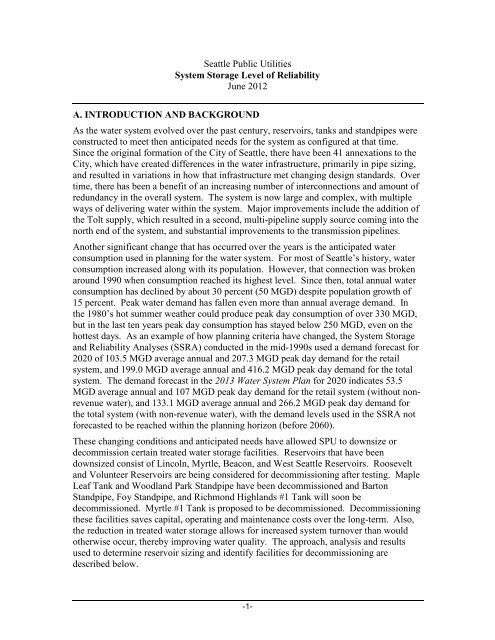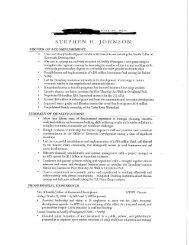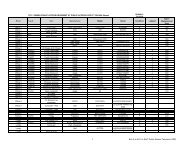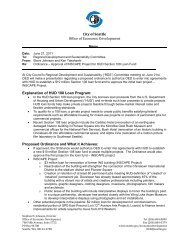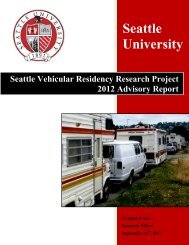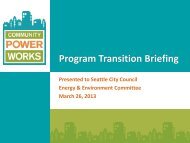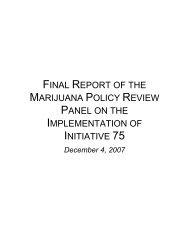2013 Water System Plan, Volume II - Seattle City Clerk's Office - City ...
2013 Water System Plan, Volume II - Seattle City Clerk's Office - City ...
2013 Water System Plan, Volume II - Seattle City Clerk's Office - City ...
You also want an ePaper? Increase the reach of your titles
YUMPU automatically turns print PDFs into web optimized ePapers that Google loves.
<strong>Seattle</strong> Public Utilities<br />
<strong>System</strong> Storage Level of Reliability<br />
June 2012<br />
A. INTRODUCTION AND BACKGROUND<br />
As the water system evolved over the past century, reservoirs, tanks and standpipes were<br />
constructed to meet then anticipated needs for the system as configured at that time.<br />
Since the original formation of the <strong>City</strong> of <strong>Seattle</strong>, there have been 41 annexations to the<br />
<strong>City</strong>, which have created differences in the water infrastructure, primarily in pipe sizing,<br />
and resulted in variations in how that infrastructure met changing design standards. Over<br />
time, there has been a benefit of an increasing number of interconnections and amount of<br />
redundancy in the overall system. The system is now large and complex, with multiple<br />
ways of delivering water within the system. Major improvements include the addition of<br />
the Tolt supply, which resulted in a second, multi-pipeline supply source coming into the<br />
north end of the system, and substantial improvements to the transmission pipelines.<br />
Another significant change that has occurred over the years is the anticipated water<br />
consumption used in planning for the water system. For most of <strong>Seattle</strong>’s history, water<br />
consumption increased along with its population. However, that connection was broken<br />
around 1990 when consumption reached its highest level. Since then, total annual water<br />
consumption has declined by about 30 percent (50 MGD) despite population growth of<br />
15 percent. Peak water demand has fallen even more than annual average demand. In<br />
the 1980’s hot summer weather could produce peak day consumption of over 330 MGD,<br />
but in the last ten years peak day consumption has stayed below 250 MGD, even on the<br />
hottest days. As an example of how planning criteria have changed, the <strong>System</strong> Storage<br />
and Reliability Analyses (SSRA) conducted in the mid-1990s used a demand forecast for<br />
2020 of 103.5 MGD average annual and 207.3 MGD peak day demand for the retail<br />
system, and 199.0 MGD average annual and 416.2 MGD peak day demand for the total<br />
system. The demand forecast in the <strong>2013</strong> <strong>Water</strong> <strong>System</strong> <strong>Plan</strong> for 2020 indicates 53.5<br />
MGD average annual and 107 MGD peak day demand for the retail system (without nonrevenue<br />
water), and 133.1 MGD average annual and 266.2 MGD peak day demand for<br />
the total system (with non-revenue water), with the demand levels used in the SSRA not<br />
forecasted to be reached within the planning horizon (before 2060).<br />
These changing conditions and anticipated needs have allowed SPU to downsize or<br />
decommission certain treated water storage facilities. Reservoirs that have been<br />
downsized consist of Lincoln, Myrtle, Beacon, and West <strong>Seattle</strong> Reservoirs. Roosevelt<br />
and Volunteer Reservoirs are being considered for decommissioning after testing. Maple<br />
Leaf Tank and Woodland Park Standpipe have been decommissioned and Barton<br />
Standpipe, Foy Standpipe, and Richmond Highlands #1 Tank will soon be<br />
decommissioned. Myrtle #1 Tank is proposed to be decommissioned. Decommissioning<br />
these facilities saves capital, operating and maintenance costs over the long-term. Also,<br />
the reduction in treated water storage allows for increased system turnover than would<br />
otherwise occur, thereby improving water quality. The approach, analysis and results<br />
used to determine reservoir sizing and identify facilities for decommissioning are<br />
described below.<br />
-1-


